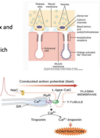Pharmacology and Therapeutics Flashcards
(61 cards)
What are some of the risk factors for CKD progression?
CVD
Hypertension
Diabetes
Smoking
AKIs
African origin
Chronic use of NSAIDs
Urinary tract outflow obstruction
What are the indications for starting RRT?
Uremia starting to effect daily life
Biochemical measures (hyperkalemia/acidosis)
Fluid overload
eGFR of 5-7ml/min/1.73m2
What are the 2 different types of dialysis?
Haemodialysis –> Transfer of uraemic solutes from the blood by diffusion via a semi-permeable membrane
Requires a fistula, or a line/graft (which has an increased risk of infections)
LMWHs are added to prevent clots, and bicarbonate is added to the blood
Peritoneal –> Access to the peritoneal cavity allows continuous dialysis whilst at home, with only the bags needing to be changed 4 times per day

What 3 vaccines are compulsory before starting dialysis?
Hep B
Influenza
Pneumonia
What is the effect of volume of distribution on the removal of drugs by dialysis?
Over 2L/Kg –> Not removed
Under 1L/Kg –> Removed significanlty by dialysis
What is the effect of protein binding in dialysis?
Only the unbound (free) drug can be removed in dialysis
Over 80% bound means that no drug will be dialysed
What is the “Triad of General Anasthesia”?
Unconsiousness
Analgesia
Muscle Relaxation
Name some of the key characteristics of the ideal general anaesthetic
Stable and potent
Controllable –> So it can be turned off if needed
Minimal cardio/resipiratory depressent
Non-irritant

What are the 4 stages of anasthesia?
Stage 1 (Analgesia) –> Consiousness and drowsiness
Stage 2 (Excitement) –> Loss of consiouness, but delirium occurs, spaciticity, gagging and vomiting
This stage needs to be minimised!
Stage 3 (Anasthesia) –> Regular respiration, loss of reflex and muscle tone
Stage 4 (Medulllary Paralysis) –> Cardiorespiration depression and so death
Dont want to push it this far!!

What are the 2 types of general anasthetic?
Inhalation –> Controllable with rapid blood-gas exchange
Stable and potent
Usually halogenated ethers or hydrocarbons
Used to maintain unconsiousness
Intravenous –> Rapid and short acting. Normally used for the induction of anasthesia
Explain the difference between the lipid and protein theory of anasthesia
Lipid –> Anasthetic potency is proportional to lipid solubility
The drug binds to lipid membranes and causes the shape of Na+ channels to change, meaning they’re less effective
Protein –> States that anasthetics bind to membrane proteins and receptors
Eg, potency correlates with luciferase inhibition
How does halothane affect K+ channels?
Cause them to open, meaning that APs are less likely to occur

In what stage of anaesthesia are muscle spasms most likely?
Stage 2
‘Excitement stage’

What is a motor unit?
The motor neuron and the muscle fibre that it innervates

What is the make up of nicotinic receptors in skeletal muscle?
2 alpha
1 beta
1 delta
1 gamma
2 moleucles of ACh must bind to activate it (with Na+ going in and K+ going out….cause end plate depolarisation)

What is the mechanism of muscle contraction?
ACh binds to Na+ channels, causing depolarisation at the end plate. This causes VG Na+ channels to open, causing APs to fire further into the muscle
This depolarisation causes VG Ca2+ to open, causing calcium-dependent calcium release from the SR. This calcium then binds to troponin which causes muscular contraction

What are the 2 types of Neuromuscular Junction blocking drugs?
Non-Depolarising (competitive antagonists) –> Acts by blocking ACh
Reversible by increase ACh levels (neostigmine)
Depolarising –> Weak nicotinic agonists
What % of ACh receptors needs to be blocked to prevent synaptic transmission at NMJs?
90% of receptors

What determins the rate of recovery, in terms of non-depolarising NMJ blockers?
Susceptibility to cholinesterases and clearance

What are the 3 main side effects of non-depolarising NMJ blockers?
Hypotension –> Due to the blockade
Histamine release from mast cells
Respiratory faliure
What type of molecules are depolarising NMJ blockers?
Symmetrical bisquarternary ammonium compounds

How do depolarising NMJ blockers work?
Bind and activate the nicotinic receptor, opening Na+ channels and causing depolarisation
They are slowly hydrolysed by cholinesterases, but the depolrisation is kept at the end plate
The Na+ channels become refractory, and so further binding of nictonic agonists has no effect, causing Ca2+ to build up….making the muscles flacid
The persistant stimulation that also occurs causes the receptors to desensitise. Therefore when the muscle does partially repolarise it has no effect (transmission is still blocked)

What are the main problems with depolarising NMBs?
Initial Muscle Twitching –> Due to initial depolarisation
Bradycardia
Post-op pain
Prolonged paralysis –> ONLY in cholinesterase deficinet patients
Hyperkalemia

What is the train of 4?
A way of assessing anasthetic depth
Usually 4 stimulatons would cause 4 APs, but when done with NMBs the response is reduced
Non Depolarising produces a greater first reponse due to the higher ACh levels (due to ACh block)










